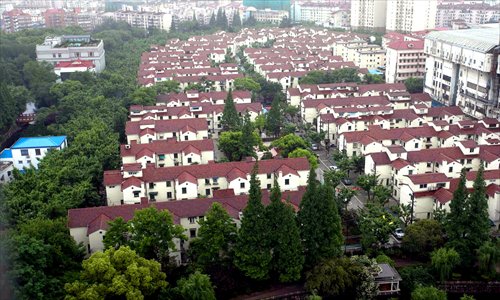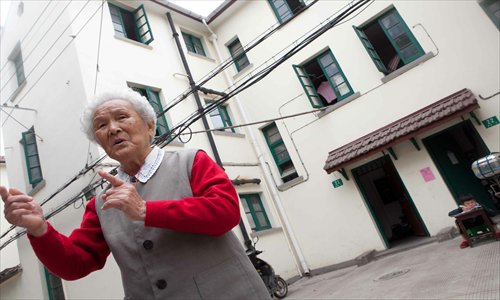Model homes for model workers

"For me, the Caoyang New Workers' Village means my grandmother's home, the address on my birth certificate, the playground on Lanxi Road and all the best and worst things in my childhood." Zhang Qiwei recalls his upbringing in one of the city's most significant housing projects in the 1950s.
To solve the severe accommodation shortages for Shanghai's 3 million workers after the city's liberation in 1951, the Shanghai Municipal People's Government set up the Shanghai Workers Housing Construction Committee. Pan Hannian, a former vice mayor of Shanghai, was in charge of the construction of the workers' villages.
This workers' village was sited north of Zhongshan Road North and to the west of Caoyang Road. Although it was on the outskirts of Shanghai at that time, it was not far from the factory districts of Changning, Putuo and Zhabei.
In September 1951, the first phase of the village project was launched and it was completed in May 1952. This is what is today known as the first Caoyang New Village. The 48 buildings spread over 13.3 hectares and 1,002 families quickly moved in to the first socialist workers' village in China.
After that construction began on several other worker accommodation projects like the next eight Caoyang New Villages which were built in the eastern and western industrial areas of Shanghai in Putuo and Yangpu districts. Many of Shanghai's model workers moved into these new villages. Zhang Qiwei's grandmother Fang Linzhen was allocated an apartment in the fifth Caoyang New Village in 1954.
A great honor
"She was a model worker at the Huatong Switch Factory. Every one in her factory loved her," recalled Zhang Guiqin, Zhang Qiwei's mother. Fang Linzhen had five children and even now, 10 years after Fang passed away, her children regard her nomination as a model worker one of the greatest honors.
Being named a model worker is one of the most prestigious honors awarded in China and is given to people who have made a significant contribution to the country through their hard work. In the early days people used to refer to model workers as "old bulls" - a reference to the heavy work an old bull would carry out without complaint.
"In those days families had lots of children and most workers had trouble finding accommodation. Model workers and senior staff were given priority when homes were allocated," Zhang Guiqin told the Global Times. More than 10 of the apartment blocks in the fifth Caoyang New Village were allocated to the Huatong Switch Factory and Shanghai Mint. As a Huatong Switch Factory model worker, Fang was awarded a large apartment.
"It was in a half-timbered three-story building. We lived in the second floor in room number 8. There were four families on each floor, which shared a kitchen, a bathroom and two toilets." Zhang recalled. She was born in 1946 and as a child remembered living in a room in a shikumen on Guling Road, Huangpu district. "There was no running water or toilet there. It was primitive."
Moving into the New Village was "like a dream." Although Zhang can't recall all the details she remembers distinctly that the day the family moved in it was sunny and the sun seemed to shine on everyone.
Other facilities
With the construction of the workers' village the city authorities began building other facilities in the area. Zhang found herself enrolled in the newly built Shanghai Caoyang No.2 Primary School.
Her junior and senior high schools - Shanghai Caoyang Middle School and Shanghai Caoyang No.2 High School - were both built in the early 1950s as were the Caoyang Red Cross Hospital, Caoyang market and shops.
Zhang moved in when she was 8, leaving the village in 1963 when she went to university. During the Cultural Revolution (1966-76) she found herself in Anhui Province and when she returned to Shanghai she worked at the Natural History Museum. She regards the nine years living at Caoyang New Village as the happiest days of her life.
"It was modern for the times and we got on well with the neighbors. It was a good atmosphere there."
But the pleasant friendly modern lifestyle that Zhang and her family enjoyed in the new village was not universal. Just in front of Zhang's family home a series of basic two-story apartment blocks were thrown up.
"Unlike our place these had five families living on each floor and there was one kitchen and toilets on the ground floor for everyone to share," she said. One of Zhang's classmates lived in one of these blocks and sometimes came to Zhang's home to use the toilet. "Even if we had to wait sometimes for a bath we were a lot better off than those people."
In 1952, the Shanghai Municipal Government began building 21,830 similar apartment blocks throughout the city to accommodate more than 102,000 people. They became known as "The 20,000 Households."
Wang Weiqiang is a professor with the College of Architecture and Urban Planning at Tongji University. He told the Global Times: "The first Caoyang New Village cost 70 yuan ($11.5) per square meter but for the construction of 'The 20,000 Households' the cost dropped to 40 yuan a square meter."

Solving problems
Wang said "The 20,000 Households" plan was intended to solve the housing problems for the workers who were living in slums at that stage. "At the time, there were many social problems that had to be solved. The housing aspirations for model workers had to be addressed alongside the wishes of the slum dwellers to move to better accommodation.
"Even in a socialist country, it was not fair on everyone. The accommodation for model workers and the rooms for ordinary workers were very different." Wang said the funding for these apartment buildings was different as well.
Spurred by the government's building plans some of the larger government companies then funded their own housing projects along the lines of "The 20,000 Households." The Shanghai Bus Company, the Shanghai Boiler Plant and the Shanghai Medical Apparatus and Instruments Factory all built accommodation for their workers.
But "The 20,000 Households" buildings have not survived over the years. Although they provided accommodation for workers when this was desperately needed most of the crudely designed and built blocks had been demolished by the early 2000s.
One of the people who has enjoyed the benefits of a workers' village home is Zang Yinfang, a 91-year-old woman. Her husband, who died five years ago, worked at the Shanghai Public Health Clinic Center and in 1958 they were allocated a room in the Yutian New Village.
"Before moving there my husband and I and four children lived with my mother-in-law in a tiny room in a one-story block on Chongqing Road North. We got lucky when the hospital was allocated some apartments. We were really grateful to the Party and to the country," said Zang.
For 55 years Zang lived in the Yutian New Village room, raising her children, seeing them leave home and then get married. The apartment buildings underwent several renovations over that time. Floors were added, and private bathrooms and toilets were installed. Zang said that in the early 1990s, the family bought the apartment for about 4,000 yuan.
Significant bonus
Although pay for workers in China was very low in those days, being offered accommodation was a significant bonus, observed Christopher Connery, a professor of literature at the University of California Santa Cruz and Shanghai University. "It showed the power of the working class."
While at university in the US, Connery visited China in 1976 with other students, teachers and workers. A highlight was visiting one of the new workers' villages. He told the Global Times that this left a lasting impression on him.
Connery said that for the 30 years after the new republic was founded, a "production first, living second" tenet prevailed in China. Shanghai also followed this rule, paying more attention to the development of productivity than urban infrastructure and housing. However, the workers' villages challenged this view.
The workers' villages were not just about housing but also a way of life. For Connery the villages are the combination of architecture, urban planning and true socialism.
Tang Weijie is an associate professor with the School of Humanities at Tongji University and he agrees with Connery that the workers' villages gave people a dream of a new lifestyle and ideology. "However, there is a huge gap between socialist China's expectations and dreams and the actual economic base."
There were two main construction periods for worker villages in Shanghai - from the 1950s to the Cultural Revolution and from 1976 to the 1980s. The era of workers' villages has long passed.

Student homes
Many of the villages are dilapidated and faded. Some of the older residents have died, younger people have moved out. Today many of them are home to students who find rooms affordable.
Tongji University's Wang would like to see the villages preserved - UNESCO has suggested that architecture more than 30 years old can be worth preserving. "They are the memories of an earlier generation," Wang said. He believes the villages have an important place in history.
While some experts think the villages could be preserved as living museums, Wang said that there were so many of them that they were still needed to provide housing for people. He said they could all be renovated and updated.
"After my grandmother's death, the apartment was given back to the country. Although none of the family lives there now we have fond memories of it. I took my 2-year-old daughter back to Caoyang once. Although everything has changed, the old building still looked good," said Zhang Qiwei.